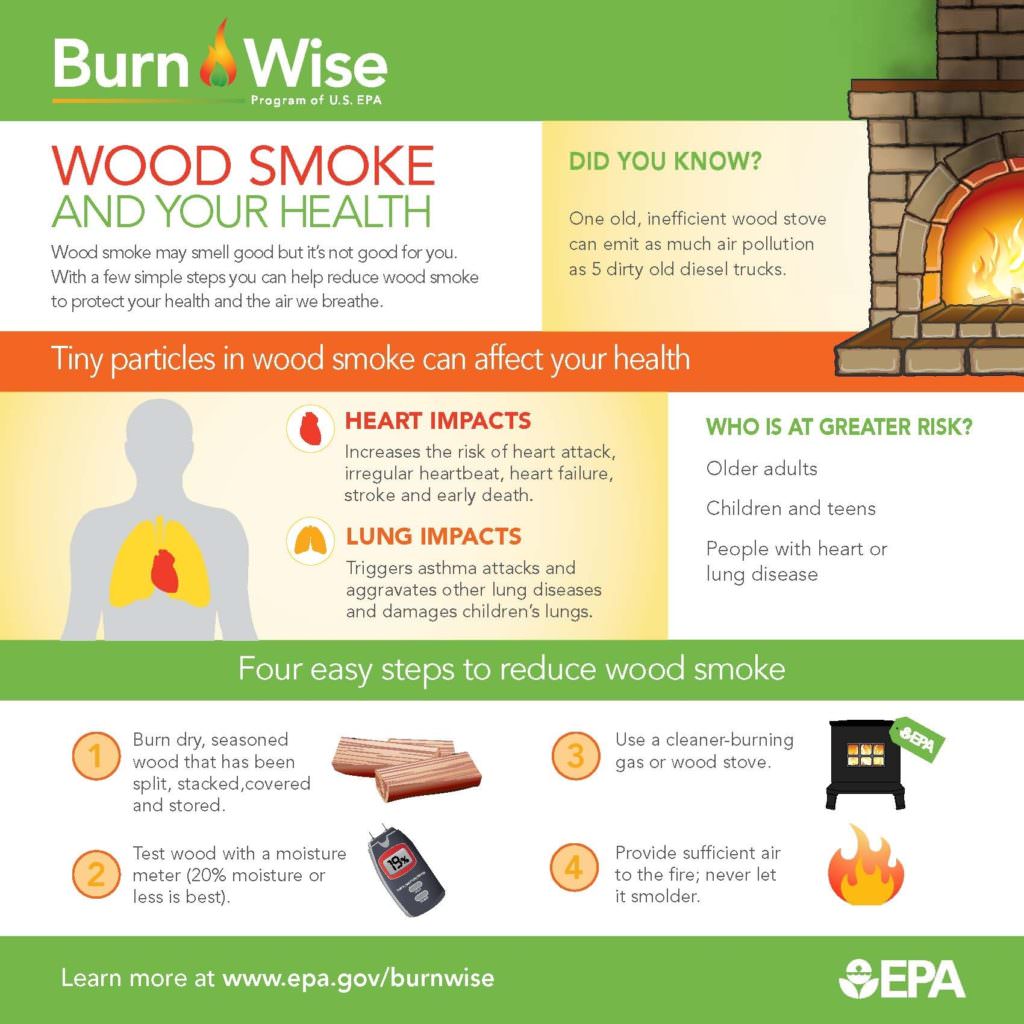Nearly everyone loves the smell of wood smoke. It evokes carefree summer nights under the stars and cozy winter evenings relaxing in front of the fireplace. But the smoke storms caused by extreme wildfire seasons in recent years have been a stark reminder that there can be too much of a good thing.
In the case of wood smoke, it doesn’t take a wildfire to be unhealthy for people and the environment. Wood smoke might smell better than car exhaust, but it is also an environmental pollutant that contributes to serious health impacts. In fact, an old wood stove can emit as much air pollution as five diesel trucks.
Wood Smoke
Smoke, regardless of what material is burning, contains fine particles, including dust and soot. Called particle pollution or particulate matter, these particles range in size from visible to microscopic. Fine particles that are 2.5 µm (micrometers) in diameter or smaller are not visible like dust or soot, but they can become lodged in the respiratory tract. When you look up your local air quality, this fine particulate matter is usually the primary statistic, reported as “PM2.5.”

Particulate matter can damage the lungs, triggering asthma, heart attacks, stroke, irregular heart rhythms, and even heart failure in people who are already at risk for these conditions. Even people who are not at-risk will experience eye and sinus irritation from particle pollution. When pollution is severe, it can lead to bronchitis and other respiratory ailments.

Image source: EPA.gov
The smoke from burning wood also includes several toxic chemicals, including benzene, formaldehyde, acrolein, and polycyclic aromatic hydrocarbons (PAHs). PAHs are found in soot and tar, and are among the same chemicals that make cigarettes so harmful. Incomplete combustion of wood releases more of these toxic chemicals, as well as carbon monoxide. More than 150 people die annually from carbon monoxide poisoning related to home heating.
Burn Less
In developed countries, the simplest way to avoid pollution from wood smoke is to stop burning wood. But psychological and economic forces make it unlikely that we will abandon burning wood completely. Even so, we can be more judicious about when and how much we burn wood. If you have a fireplace or woodstove at home, avoid using it during seasons when warmer temperatures allow smoke to settle around the house.
Many people have a hard time imagining camping without a campfire. Cooking over an open fire, making s’mores, and sitting around the fire under the stars are all iconic camping experiences. But nowadays many areas institute burn bans throughout much of the year. Complying with burn bans is not optional – campfires have caused more than 11,000 wildfires in the U.S. since 2006.
It might not be as picturesque, but a propane camp stove is much safer than a campfire. And if you want to avoid an open flame altogether, consider a solar oven.

Campfires have caused more than 11,000 wildfires in the U.S. since 2006. Image by skeeze on Pixabay
Burn Cleaner
In parts of the world where people depend on wood fires for cooking, traditional cookstoves are a greater health risk factor than poor water, sanitation, and other environmental hazards. In these places, people need cleaner cookstoves to replace open fires.
Incomplete burning releases more smoke and toxic chemicals. For complete combustion, only use dry, seasoned wood or cleaner-burning manufactured fire logs; learn how to build a fire that catches quickly, and always put out your fire completely. A smoldering fire also releases more smoke and harmful chemicals. And never burn garbage, treated lumber, or plastics.
Standard fireplaces put out 28 times as much particulate matter as a new wood stove, and a pellet stove releases about half of what a new wood stove puts out. Both wood and gas-burning fireplace inserts generate less smoke and provide the same amount of heat with less fuel than an open fireplace. If you have a wood-burning fireplace, have it inspected annually by a chimney sweep certified by the Chimney Safety Institute of America to make sure it’s operating properly.
Wood stoves should also be inspected annually for safety and efficiency. Older woodstoves release 15 to 30 grams of smoke per hour. New, EPA-certified stoves produce 4.5 grams per hour or less. When you’re ready to upgrade your stove, check the current list of EPA-certified wood heaters or consider switching your home to a cleaner heating system. And no matter what heat source you use, make sure you heat your home as efficiently as possible.
The post The Problem With That Wood Smoke Smell appeared first on Earth 911.







